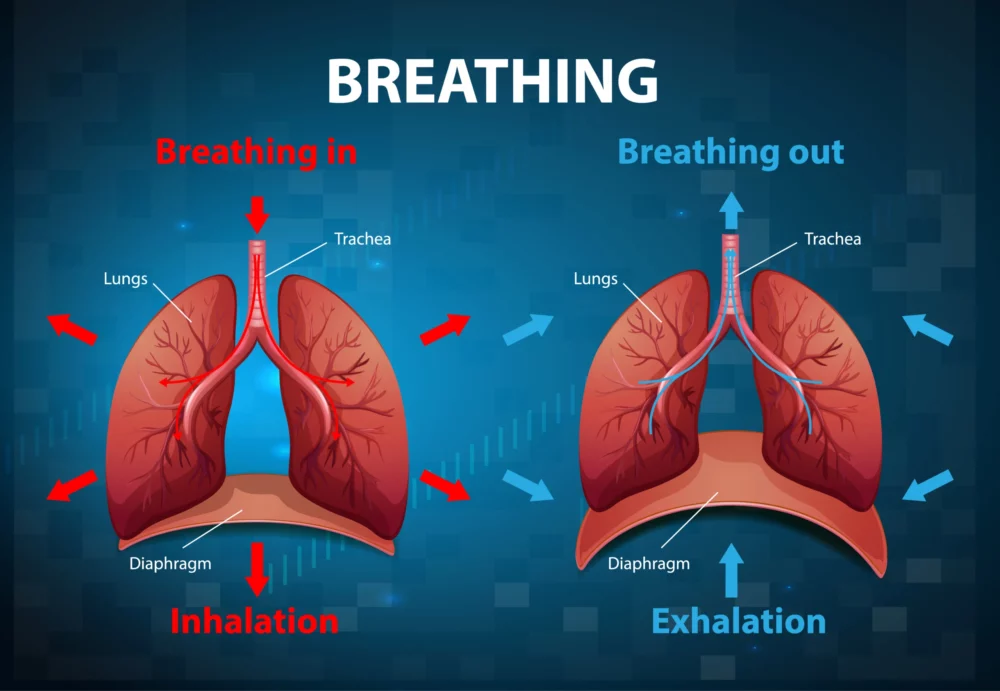Respiration is a fundamental process for all living organisms, ensuring the supply of oxygen and the removal of carbon dioxide, critical for sustaining life. While “breathing” is a term we commonly associate with the respiratory process, it is essential to recognize that respiration is a multifaceted concept, involving both mechanical actions and intricate physiological processes. In this exploration, we unravel the respiratory puzzle, delving into the distinctions between “gaseous exchange” and “breathing” and understanding how they contribute to the body’s overall oxygen supply and waste removal.
Breathing: The Mechanical Act
Breathing, or ventilation, is the physical act of moving air in and out of the lungs. It is a fundamental process, necessary to provide fresh oxygen to the body’s cells and to eliminate carbon dioxide, a metabolic waste product.
Mechanically, breathing is a cyclic process composed of two phases:
Inhalation (Inspiration): During inhalation, the diaphragm contracts and flattens, and the intercostal muscles between the ribs contract. These actions increase the volume of the chest cavity, causing a drop in air pressure within the lungs. As a result, air is drawn in through the nose and mouth, passing through the respiratory passages to reach the alveoli in the lungs.
Exhalation (Expiration): Exhalation is a passive process in which the diaphragm and intercostal muscles relax. This reduces the volume of the chest cavity, increasing the air pressure within the lungs. Air is then expelled from the lungs, carrying with it carbon dioxide, which is eventually exhaled.
The primary purpose of breathing is to ensure the exchange of gases between the atmosphere and the body. Oxygen from the air is taken into the lungs and transported to the body’s cells via the bloodstream, while carbon dioxide produced by cellular metabolism is removed from the body.
Gaseous Exchange: The Physiological Process
Gaseous exchange, often referred to as gas exchange or respiration at the cellular level, is the physiological process by which oxygen and carbon dioxide are exchanged between the bloodstream and body tissues and cells. This process is the cornerstone of aerobic metabolism, providing cells with the oxygen they need to produce energy through cellular respiration.
Gaseous exchange occurs at two primary levels:
External Respiration: This occurs in the tiny air sacs of the lungs called alveoli. During external respiration, oxygen from inhaled air diffuses across the walls of the alveoli into the bloodstream, binding to hemoglobin in red blood cells. Simultaneously, carbon dioxide, a waste product of cellular metabolism, diffuses from the bloodstream into the alveoli to be expelled during exhalation.
Internal Respiration (Cellular Respiration): After oxygen-rich blood leaves the lungs, it is pumped by the heart to various tissues and cells throughout the body. At the cellular level, oxygen is released from hemoglobin and diffuses into the cells, where it is used in aerobic cellular respiration. During this process, glucose and oxygen combine to produce energy (in the form of ATP), water, and carbon dioxide. Carbon dioxide, a byproduct of cellular respiration, diffuses out of the cells into the bloodstream, where it is carried back to the lungs for exhalation.
Connecting the Dots: How They Work Together
Understanding the relationship between gaseous exchange and breathing is crucial for comprehending the holistic respiratory process. Breathing serves as the mechanical means to ensure that fresh air, containing oxygen, reaches the lungs and stale air, enriched with carbon dioxide, is expelled.
Once oxygen is in the lungs (thanks to the mechanical act of breathing), it embarks on a journey through the bloodstream to reach cells throughout the body. At the cellular level, gaseous exchange takes over. Oxygen diffuses from the bloodstream into the cells, where it participates in energy production, while carbon dioxide produced by cells returns to the bloodstream and is carried back to the lungs for exhalation during the breathing process.
In essence, breathing provides the means for oxygen to reach the cells, while gaseous exchange ensures that oxygen and carbon dioxide are effectively exchanged between the bloodstream and body cells to sustain vital metabolic processes.
The Respiratory Symphony
In the intricate symphony of respiration, “breathing” represents the conductor, orchestrating the mechanical movements that facilitate the exchange of gases between the atmosphere and the lungs. “Gaseous exchange,” on the other hand, is the virtuoso performer, executing the critical physiological exchanges of oxygen and carbon dioxide at both the pulmonary and cellular levels. Together, these two components create a harmonious collaboration, allowing us to breathe and providing our cells with the oxygen needed for life-sustaining energy production. The respiratory puzzle is now unveiled, revealing the interplay between these essential processes.
Image by brgfx on Freepik





Leave a Reply
You must be logged in to post a comment.